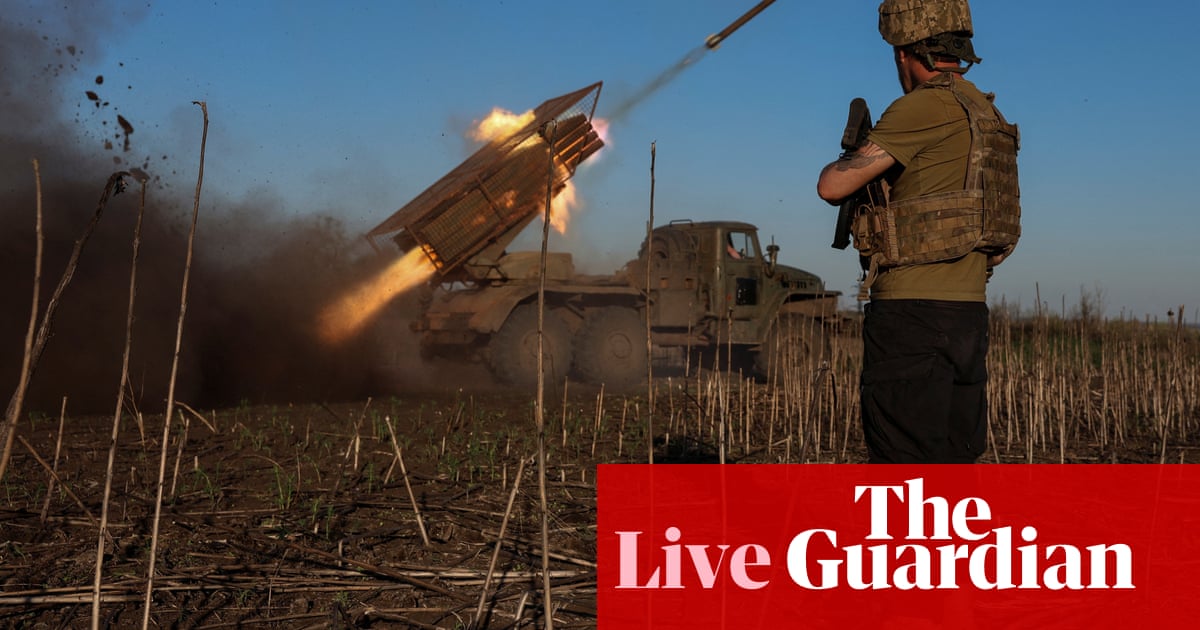Welcome back to our live coverage of Russia’s war onUkraine.
Ukraine’s military has reported Russian drone attacks on several regions overnight, hours after the 30 hour “Easter ceasefire” declared by Vladimir Putin came to an end.
In a televised meeting with his commander-in-chief on Saturday, the Russian presidentsaidthe temporary ceasefire would last from 6pm Moscow time (4pm BST) on Saturday until midnight (10pm BST) on Sunday.
Putin claimed he had ordered his forces to “stop all military activity” along the frontline during this window for “humanitarian reasons”. But both Kyiv and Moscow accused each other of violating the ceasefire, with drone strikes and shelling.
Ukraine’s air force said today thatRussialaunched 96 drones and three missiles in overnight attacks targeting Ukraine, causing damage in the Kharkiv, Dnipropetrovsk and Cherkasy regions.
Air defence units shot down 42 Russian drones, and another 47 drones were redirected by electronic warfare, the air force wrote in a post on Telegram.
Air raid alerts have reportedly been activated in Kyiv, Kherson, Dnipropetrovsk, Cherkasy, Mykolaiv and Zaporizhzhia.
There were no immediate reports of injuries or major damages from the attacks, regional Ukrainian officials said on social media.
In some other developments:
Volodymyr Zelenskyydismissed Vladimir Putin’s Easter ceasefire declarationas a fake “PR” exercise and said Russian troops hadcontinued their drone and artillery attacksacross many parts of the frontline on Sunday. He claimed Moscow had violated its own ceasefire thousands of times.
Washington said it would welcome an extension of the truce, and Zelenskyy said Ukraine would pause strikes for 30 days. Putin, however, did not give orders to extend the 30 hour truce beyond Sunday.
Donald Trumpused the situation to claim that a breakthrough was within a few days’ reach.“Hopefully Russia and Ukraine will make a deal this week,” he posted on Sunday. “Both will then start to do big business with the United States of America, which is thriving, and make a fortune.” On Friday, Trump said he would end US peace efforts unless the two sides showed movement.
Russia’sVoronezhregion that borders Ukraine was under air raid alerts for two hours overnight, the region’s governor said on Telegram.
Russia’s defence ministry said on Sunday that Ukrainian forces had shot at Russian positions 444 times and said it had counted more than 900 Ukrainian drone attacks, saying also that there were deaths and injuries among the civilian population.
In theKhersonregion, three people were killed and three injured in Russian attacks over the past day, its governor Oleksandr Prokudin reported in a post on Telegram.
He said that Russian forces targeted residential areas and a store in the attacks.
Among those killed in the Kherson region was a woman who was hit by a drone while walking down the street, according to Gyunduz Mamedov, a former deputy prosecutor general ofUkraine. We have not yet been able to independently verify these claims and reports.
Welcome back to our live coverage of Russia’s war onUkraine.
Ukraine’s military has reported Russian drone attacks on several regions overnight, hours after the 30 hour “Easter ceasefire” declared by Vladimir Putin came to an end.
In a televised meeting with his commander-in-chief on Saturday, the Russian presidentsaidthe temporary ceasefire would last from 6pm Moscow time (4pm BST) on Saturday until midnight (10pm BST) on Sunday.
Putin claimed he had ordered his forces to “stop all military activity” along the frontline during this window for “humanitarian reasons”. But both Kyiv and Moscow accused each other of violating the ceasefire, with drone strikes and shelling.
Ukraine’s air force said today thatRussialaunched 96 drones and three missiles in overnight attacks targeting Ukraine, causing damage in the Kharkiv, Dnipropetrovsk and Cherkasy regions.
Air defence units shot down 42 Russian drones, and another 47 drones were redirected by electronic warfare, the air force wrote in a post on Telegram.
Air raid alerts have reportedly been activated in Kyiv, Kherson, Dnipropetrovsk, Cherkasy, Mykolaiv and Zaporizhzhia.
There were no immediate reports of injuries or major damages from the attacks, regional Ukrainian officials said on social media.
In some other developments:
Volodymyr Zelenskyydismissed Vladimir Putin’s Easter ceasefire declarationas a fake “PR” exercise and said Russian troops hadcontinued their drone and artillery attacksacross many parts of the frontline on Sunday. He claimed Moscow had violated its own ceasefire thousands of times.
Washington said it would welcome an extension of the truce, and Zelenskyy said Ukraine would pause strikes for 30 days. Putin, however, did not give orders to extend the 30 hour truce beyond Sunday.
Donald Trumpused the situation to claim that a breakthrough was within a few days’ reach.“Hopefully Russia and Ukraine will make a deal this week,” he posted on Sunday. “Both will then start to do big business with the United States of America, which is thriving, and make a fortune.” On Friday, Trump said he would end US peace efforts unless the two sides showed movement.
Russia’sVoronezhregion that borders Ukraine was under air raid alerts for two hours overnight, the region’s governor said on Telegram.
Russia’s defence ministry said on Sunday that Ukrainian forces had shot at Russian positions 444 times and said it had counted more than 900 Ukrainian drone attacks, saying also that there were deaths and injuries among the civilian population.
